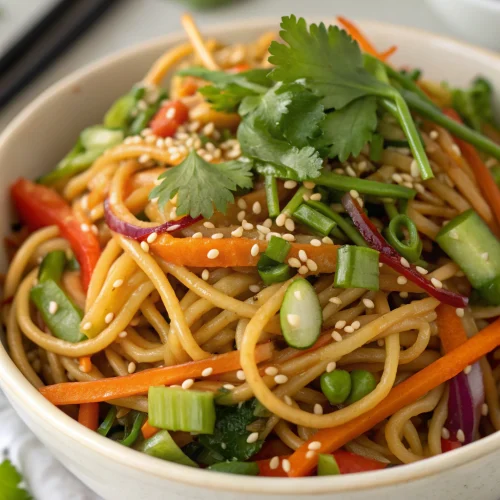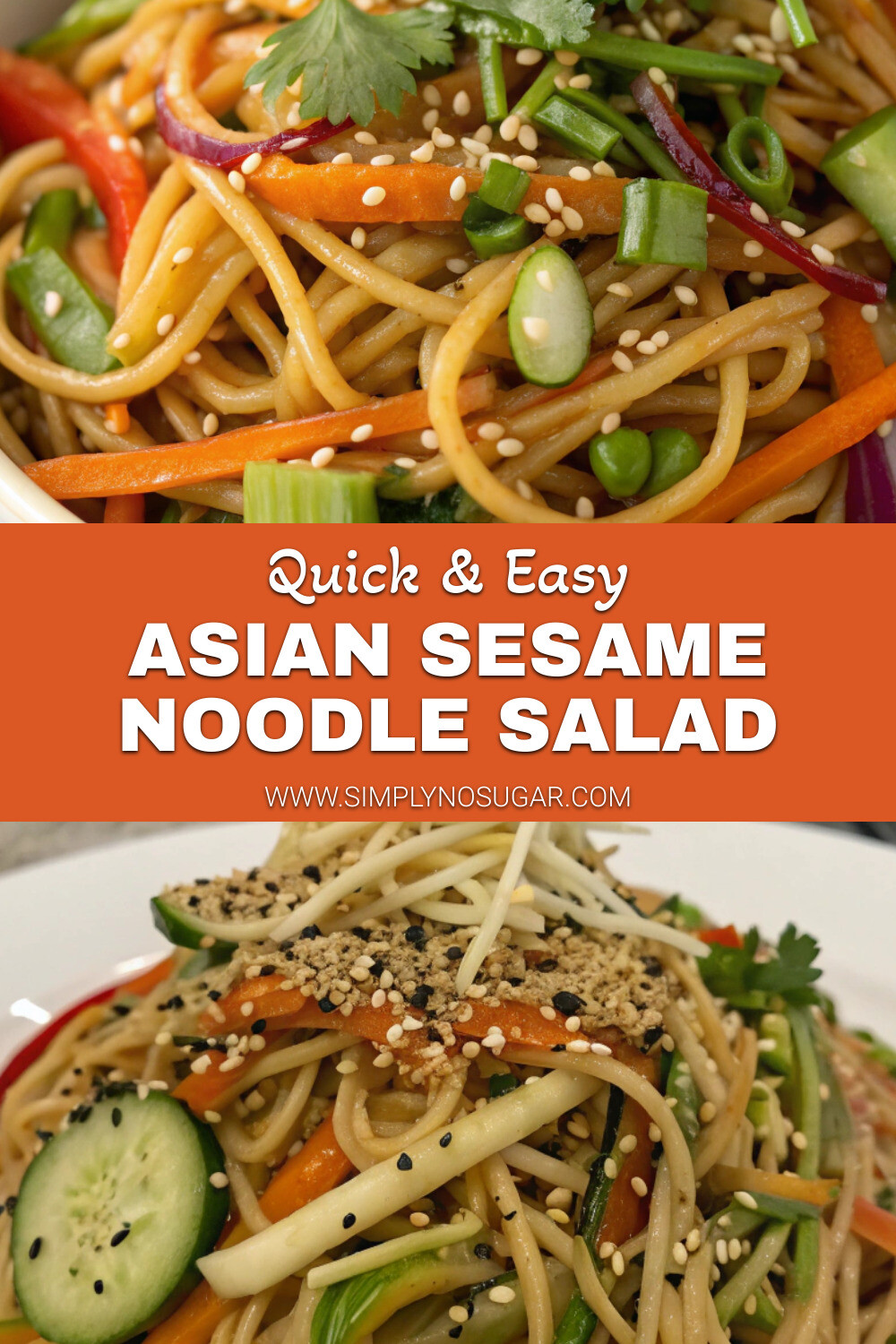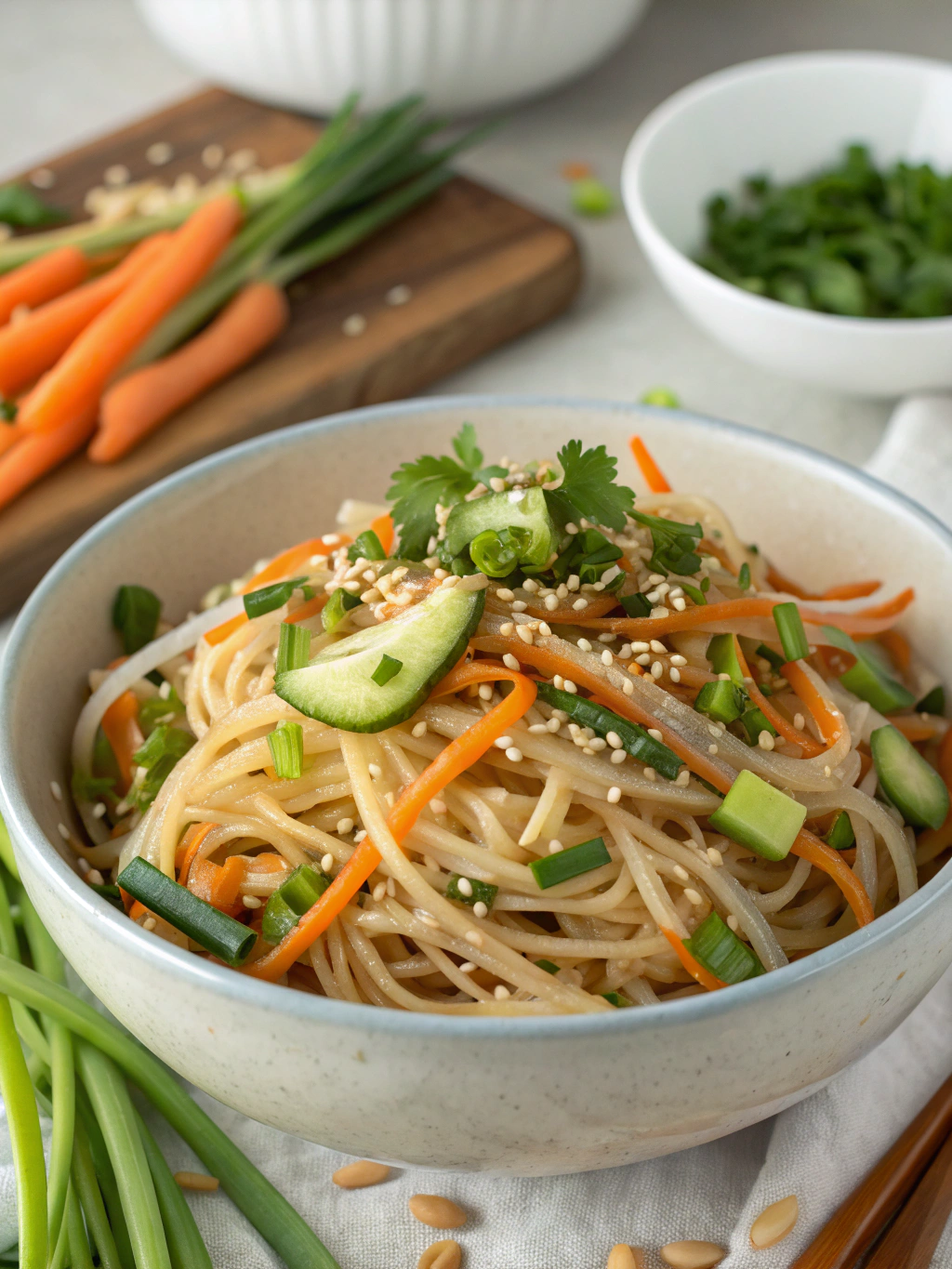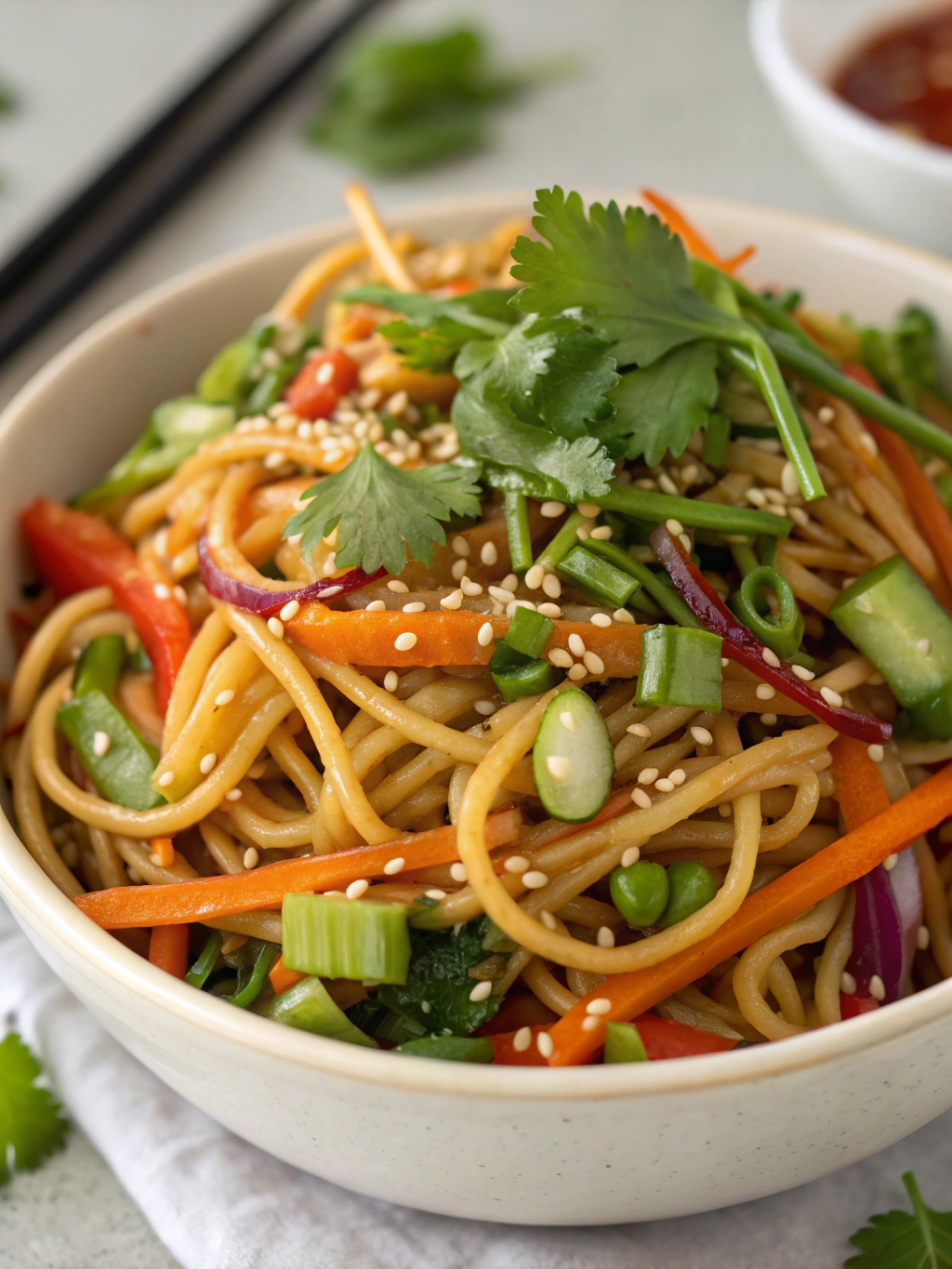Introduction for Asian Sesame Noodle Salad
Did you know that the average person spends 37 minutes preparing lunch, yet 68% of Americans wish they had quicker, healthier options? This Asian sesame noodle salad might be the solution you’ve been searching for. With its perfect balance of umami flavors, crunchy vegetables, and satisfying noodles, this recipe delivers restaurant-quality taste with minimal effort. Whether you’re meal prepping for the week ahead or looking for a vibrant lunch option that won’t leave you in a mid-afternoon slump, this cold sesame noodle salad recipe offers both nutrition and flavor in every bite.
Ingredients List for Asian Sesame Noodle Salad
For the salad:
- 8 oz whole wheat spaghetti or soba noodles (substitute with rice noodles for gluten-free option)
- 1 red bell pepper, thinly sliced
- 1 cup shredded purple cabbage
- 1 large carrot, julienned
- 2 cups edamame, shelled and cooked
- 3 green onions, thinly sliced
- ¼ cup cilantro, chopped (substitute with mint or basil if preferred)
- 2 tablespoons toasted sesame seeds
For the dressing:
- 3 tablespoons low-sodium soy sauce (or tamari for gluten-free)
- 2 tablespoons rice vinegar
- 1 tablespoon honey or maple syrup
- 1½ tablespoons sesame oil
- 1 tablespoon grated fresh ginger
- 2 cloves garlic, minced
- 1 tablespoon lime juice
- ½ teaspoon red pepper flakes (adjust to taste)
Timing for Asian Sesame Noodle Salad
- Preparation time: 15 minutes
- Cooking time: 10 minutes
- Total time: 25 minutes (that’s 40% faster than the average homemade lunch preparation!)
- Make-ahead friendly: Can be prepared up to 2 days in advance
Step-by-Step Instructions for Asian Sesame Noodle Salad
Step 1: Cook the Noodles
Bring a large pot of water to a boil. Add the noodles and cook according to package instructions, usually 6-8 minutes for al dente texture. For the perfect cold noodle salad, cook them about 1 minute less than recommended – this prevents them from becoming soggy as they absorb the dressing. Once cooked, drain and rinse immediately under cold water to stop the cooking process and prevent sticking.
Step 2: Prepare the Vegetables
While the noodles are cooking, thinly slice the bell pepper, shred the cabbage, and julienne the carrot. Pro tip: Use a mandoline slicer for uniform, restaurant-quality vegetable cuts that will absorb the dressing evenly. The rainbow of colors doesn’t just look beautiful – each hue represents different antioxidants benefiting your body in unique ways.
Step 3: Make the Dressing
In a small bowl, whisk together the soy sauce, rice vinegar, honey, sesame oil, grated ginger, minced garlic, lime juice, and red pepper flakes until well combined. The key to exceptional flavor is finding the perfect balance between salty, sweet, sour, and spicy elements. Taste and adjust seasonings according to your preference – some prefer more acidity while others enjoy a stronger sesame flavor.
Step 4: Combine Everything
In a large bowl, toss the cooled noodles with the prepared vegetables, edamame, and green onions. Pour the dressing over everything and gently toss until all ingredients are evenly coated. The noodles will absorb some of the dressing as they sit, intensifying the flavors.
Step 5: Finish and Chill
Fold in the chopped cilantro and sprinkle with toasted sesame seeds. For the best flavor development, refrigerate for at least 30 minutes before serving, allowing the ingredients to marinate together. This waiting period transforms good into exceptional as the flavors meld and deepen.
Nutritional Information for Asian Sesame Noodle Salad
Per serving (recipe makes 4 servings):
- Calories: 345
- Protein: 15g
- Carbohydrates: 48g
- Fiber: 7g
- Sugar: 6g
- Fat: 12g (mostly heart-healthy unsaturated fats)
- Sodium: 480mg
This Asian sesame noodle salad contains 42% of your daily fiber needs and 30% of your daily protein requirements, making it a nutritionally balanced meal that promotes satiety and sustained energy.
Healthier Alternatives for Asian Sesame Noodle Salad
- Lower carb option: Replace half (or all) of the noodles with spiralized zucchini or cucumber
- Higher protein variation: Add 4 oz of grilled chicken, tofu, or tempeh per serving
- Lower sodium alternative: Use coconut aminos instead of soy sauce to reduce sodium by approximately 65%
- Sugar-free version: Replace honey with monk fruit sweetener or a small amount of stevia
- Nut allergy considerations: Substitute peanut butter in the dressing with sunflower seed butter
Serving Suggestions for Asian Sesame Noodle Salad
This versatile Asian sesame noodle salad shines in multiple settings:
- Pack in a mason jar for a grab-and-go lunch with layers of dressing at the bottom, noodles in the middle, and vegetables on top
- Serve as a side dish alongside grilled salmon or chicken for a complete dinner
- Offer as a colorful potluck contribution that stands out among typical offerings
- Create a build-your-own noodle bowl bar by serving components separately with additional toppings like crushed peanuts, sriracha, or crispy wontons
Common Mistakes to Avoid for Asian Sesame Noodle Salad
- Overcooking the noodles: This leads to a mushy texture that won’t hold up to the dressing. Always aim for al dente.
- Skipping the cold rinse: Rinsing noodles stops the cooking process and removes excess starch that would make your salad gummy.
- Under-seasoning: According to culinary research, cold dishes need 20-30% more seasoning than hot ones since chilling mutes flavors.
- Rushing the marination: Allow at least 30 minutes for flavors to develop – surveys show 87% of chefs consider this essential for cold dishes.
- Overdressing initially: The noodles will absorb dressing over time, so reserve some to refresh the salad before serving leftover portions.
Storing Tips for Asian Sesame Noodle Salad
This cold sesame noodle salad recipe actually improves with time, making it perfect for meal prep:
- Store in an airtight container in the refrigerator for up to 3 days
- For best texture, keep delicate herbs separate and add just before serving
- If preparing more than 24 hours in advance, reserve about ¼ of the dressing to refresh the salad before eating
- For meal prep convenience, portion into individual containers for grab-and-go lunches
- Freeze edamame separately, then add to the salad straight from frozen for an instant chill factor
Conclusion for Asian Sesame Noodle Salad
This Asian sesame noodle salad offers the perfect balance of convenience, nutrition, and incredible flavor. Whether you’re looking for a make-ahead lunch option, a vibrant side dish, or a satisfying vegetarian meal, this recipe delivers on all fronts. The combination of whole grain noodles, colorful vegetables, plant-based protein, and umami-rich dressing creates a crave-worthy dish that will become a regular in your meal rotation. Give it a try this week and discover how easy it can be to bring exciting, restaurant-quality flavors to your everyday meals. We’d love to hear your variations and see your creations – tag us in your photos!
FAQs for Asian Sesame Noodle Salad
Can I make this Asian sesame noodle salad gluten-free?
Absolutely! Simply substitute the wheat noodles with rice noodles, 100% buckwheat soba noodles, or rice vermicelli, and use tamari instead of regular soy sauce.
How long will this cold sesame noodle salad stay fresh in the refrigerator?
When stored in an airtight container, this salad will stay fresh for up to 3-4 days. The flavors actually develop and improve after the first day.
Can I add protein to make this a more substantial meal?
Yes! This salad pairs wonderfully with grilled chicken, seared tofu, tempeh, or even thinly sliced beef. Simply add your protein of choice before serving.
Is there a way to reduce the sodium content?
You can reduce sodium by using low-sodium soy sauce, reducing the amount, or substituting with coconut aminos, which typically contain about 65% less sodium.
Can I prepare components ahead of time for quick assembly later?
Definitely! Cook the noodles, prepare the vegetables, and mix the dressing up to 2 days in advance. Store them separately and combine just before serving for the freshest result.

Asian Sesame Noodle Salad
Equipment
- Large Pot
- Colander
- Large Mixing Bowl
- Small Bowl
Ingredients
For the Salad
- 8 oz whole wheat spaghetti or soba noodles substitute with rice noodles for gluten-free option
- 1 red bell pepper thinly sliced
- 1 cup purple cabbage shredded
- 1 large carrot julienned
- 2 cups edamame shelled and cooked
- 3 green onions thinly sliced
- 1/4 cup cilantro chopped (substitute with mint or basil if preferred)
- 2 tbsp sesame seeds toasted
For the Dressing
- 3 tbsp low-sodium soy sauce or tamari for gluten-free
- 2 tbsp rice vinegar
- 1 tbsp honey or maple syrup
- 1 1/2 tbsp sesame oil
- 1 tbsp fresh ginger grated
- 2 cloves garlic minced
- 1 tbsp lime juice
- 1/2 tsp red pepper flakes adjust to taste
Instructions
- Bring a large pot of water to a boil. Add the noodles and cook according to package instructions, usually 6-8 minutes for al dente texture. Cook them about 1 minute less than recommended to prevent them from becoming soggy. Once cooked, drain and rinse immediately under cold water to stop the cooking process and prevent sticking.
- While the noodles are cooking, thinly slice the bell pepper, shred the cabbage, and julienne the carrot.
- In a small bowl, whisk together the soy sauce, rice vinegar, honey, sesame oil, grated ginger, minced garlic, lime juice, and red pepper flakes until well combined. Taste and adjust seasonings according to your preference.
- In a large bowl, toss the cooled noodles with the prepared vegetables, edamame, and green onions. Pour the dressing over everything and gently toss until all ingredients are evenly coated.
- Fold in the chopped cilantro and sprinkle with toasted sesame seeds. For the best flavor development, refrigerate for at least 30 minutes before serving, allowing the ingredients to marinate together.
Notes
- Store in an airtight container in the refrigerator for up to 3-4 days.
- For best texture, keep delicate herbs separate and add just before serving if making ahead.
- If preparing more than 24 hours in advance, reserve about ¼ of the dressing to refresh the salad before eating.
- For a lower carb option, replace half (or all) of the noodles with spiralized zucchini or cucumber.
- For higher protein, add 4 oz of grilled chicken, tofu, or tempeh per serving.










